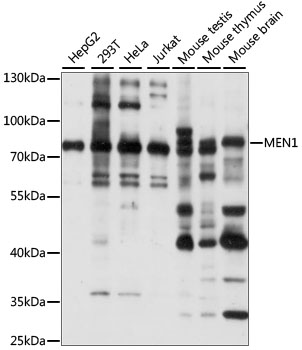Epigenetics & Nuclear Signaling Antibodies 2
Anti-MEN1 Antibody (CAB15290)
- SKU:
- CAB15290
- Product Type:
- Antibody
- Reactivity:
- Human
- Reactivity:
- Mouse
- Host Species:
- Rabbit
- Isotype:
- IgG
- Antibody Type:
- Polyclonal Antibody
- Research Area:
- Epigenetics and Nuclear Signaling
Description
| Antibody Name: | Anti-MEN1 Antibody |
| Antibody SKU: | CAB15290 |
| Antibody Size: | 20uL, 50uL, 100uL |
| Application: | WB |
| Reactivity: | Human, Mouse |
| Host Species: | Rabbit |
| Immunogen: | Recombinant fusion protein containing a sequence corresponding to amino acids 266-615 of human MEN1 (NP_000235.2). |
| Application: | WB |
| Recommended Dilution: | WB 1:200 - 1:2000 |
| Reactivity: | Human, Mouse |
| Positive Samples: | HepG2, 293T, HeLa, Jurkat, Mouse testis, Mouse thymus, Mouse brain |
| Immunogen: | Recombinant fusion protein containing a sequence corresponding to amino acids 266-615 of human MEN1 (NP_000235.2). |
| Purification Method: | Affinity purification |
| Storage Buffer: | Store at -20'C. Avoid freeze / thaw cycles. Buffer: PBS with 0.02% sodium azide, 50% glycerol, pH7.3. |
| Isotype: | IgG |
| Sequence: | QKLL WLLY DLGH LERY PMAL GNLA DLEE LEPT PGRP DPLT LYHK GIAS AKTY YRDE HIYP YMYL AGYH CRNR NVRE ALQA WADT ATVI QDYN YCRE DEEI YKEF FEVA NDVI PNLL KEAA SLLE AGEE RPGE QSQG TQSQ GSAL QDPE CFAH LLRF YDGI CKWE EGSP TPVL HVGW ATFL VQSL GRFE GQVR QKVR IVSR EAEA AEAE EPWG EEAR EGRR RGPR RESK PEEP PPPK KPAL DKGL GTGQ GAVS GPPR KPPG TVAG TARG PEGG STAQ VPAP AASP PPEG PVLT FQSE KMKG MKEL LVAT KINS SAIK LQLT AQSQ VQMK KQKV STPS DYTL SFLK RQRK GL |
| Gene ID: | 4221 |
| Uniprot: | O00255 |
| Cellular Location: | Nucleus |
| Calculated MW: | 63kDa/67kDa/68kDa |
| Observed MW: | 80kDa |
| Synonyms: | MEN1, MEAI, SCG2, menin |
| Background: | This gene encodes menin, a putative tumor suppressor associated with a syndrome known as multiple endocrine neoplasia type 1. In vitro studies have shown menin is localized to the nucleus, possesses two functional nuclear localization signals, and inhibits transcriptional activation by JunD, however, the function of this protein is not known. Two messages have been detected on northern blots but the larger message has not been characterized. Alternative splicing results in multiple transcript variants. |
| UniProt Protein Function: | MEN1: Essential component of a MLL/SET1 histone methyltransferase (HMT) complex, a complex that specifically methylates 'Lys-4' of histone H3 (H3K4). Functions as a transcriptional regulator. Binds to the TERT promoter and represses telomerase expression. Plays a role in TGFB1-mediated inhibition of cell-proliferation, possibly regulating SMAD3 transcriptional activity. Represses JUND-mediated transcriptional activation on AP1 sites, as well as that mediated by NFKB subunit RELA. Positively regulates HOXC8 and HOXC6 gene expression. May be involved in normal hematopoiesis through the activation of HOXA9 expression. May be involved in DNA repair. Component of MLL-containing complexes (named MLL, ASCOM, MLL2/MLL3 or MLL3/MLL4 complex): at least composed ASH2L, RBBP5, DPY30, WDR5, one or several histone methyltransferases (MLL, MLL2, MLL3 and/or MLL4), and the facultative components MEN1, HCFC1, HCFC2, NCOA6, KDM6A, PAXIP1/PTIP and C16orf53/PA1. Interacts with POLR2A phosphorylated at 'Ser-5', but not with the unphosphorylated, nor 'Ser-2' phosphorylated POLR2A forms. Interacts with FANCD2 and DBF4. Interacts with JUND. Interacts with SMAD3, but not with SMAD2, nor SMAD4. Directly interacts with NFKB1, NFKB2 and RELA. Ubiquitous. 3 isoforms of the human protein are produced by alternative splicing. |
| UniProt Protein Details: | Protein type:Transcription, coactivator/corepressor Chromosomal Location of Human Ortholog: 11q13 Cellular Component: chromatin; cleavage furrow; cytoplasm; cytosol; histone methyltransferase complex; nuclear chromatin; nuclear chromosome, telomeric region; nuclear matrix; nucleoplasm; nucleus; protein complex Molecular Function:chromatin binding; double-stranded DNA binding; four-way junction DNA binding; histone-lysine N-methyltransferase activity; protein binding; protein binding, bridging; protein N-terminus binding; Y-form DNA binding Biological Process: MAPKKK cascade; negative regulation of cell cycle; negative regulation of cell proliferation; negative regulation of cyclin-dependent protein kinase activity; negative regulation of JNK cascade; negative regulation of osteoblast differentiation; negative regulation of protein amino acid phosphorylation; negative regulation of telomerase activity; negative regulation of transcription factor activity; negative regulation of transcription from RNA polymerase II promoter; negative regulation of transcription, DNA-dependent; osteoblast development; positive regulation of protein binding; positive regulation of transcription from RNA polymerase II promoter; positive regulation of transforming growth factor beta receptor signaling pathway; response to DNA damage stimulus; response to gamma radiation; response to UV Disease: Multiple Endocrine Neoplasia, Type I |
| NCBI Summary: | This gene encodes menin, a putative tumor suppressor associated with a syndrome known as multiple endocrine neoplasia type 1. In vitro studies have shown menin is localized to the nucleus, possesses two functional nuclear localization signals, and inhibits transcriptional activation by JunD, however, the function of this protein is not known. Two messages have been detected on northern blots but the larger message has not been characterized. Alternative splicing results in multiple transcript variants. [provided by RefSeq, Oct 2008] |
| UniProt Code: | O00255 |
| NCBI GenInfo Identifier: | 317373574 |
| NCBI Gene ID: | 4221 |
| NCBI Accession: | O00255.4 |
| UniProt Secondary Accession: | O00255,O00632, Q9BUF0, Q9BUK2, A5HBC6, A5HBC7, A5HBC8 A5HBC9, A5HBD0, A5HBD1, A5HBD2, |
| UniProt Related Accession: | O00255 |
| Molecular Weight: | 63,748 Da |
| NCBI Full Name: | Menin |
| NCBI Synonym Full Names: | menin 1 |
| NCBI Official Symbol: | MEN1 |
| NCBI Official Synonym Symbols: | MEAI; SCG2 |
| NCBI Protein Information: | menin |
| UniProt Protein Name: | Menin |
| Protein Family: | Menin |
| UniProt Gene Name: | MEN1 |
| UniProt Entry Name: | MEN1_HUMAN |







